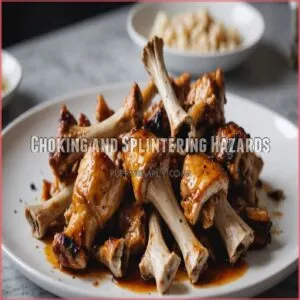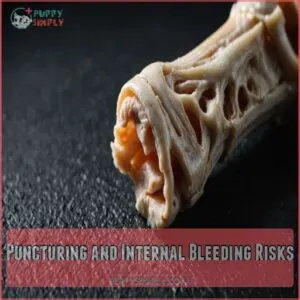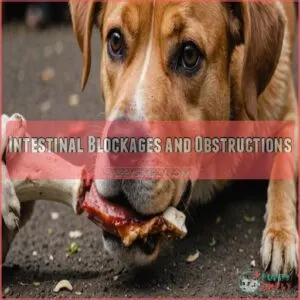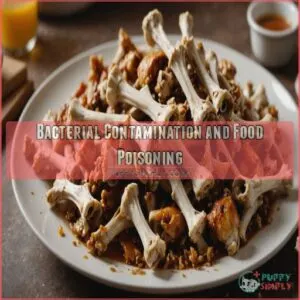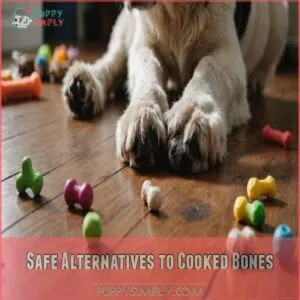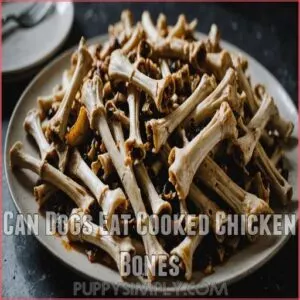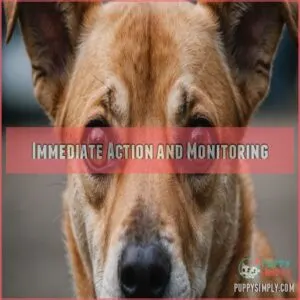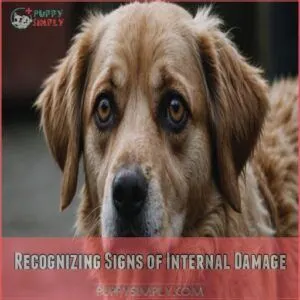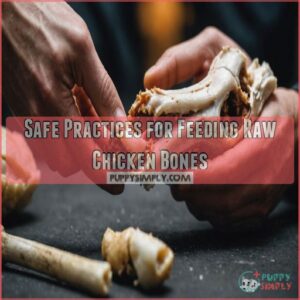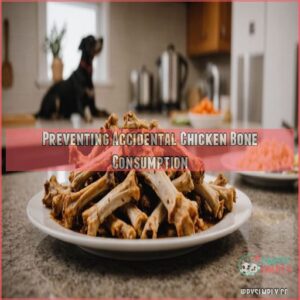This site is supported by our readers. We may earn a commission, at no cost to you, if you purchase through links.
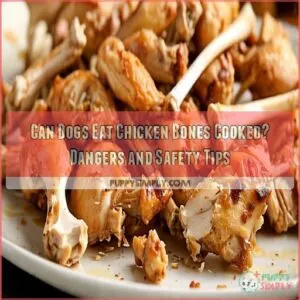 No, you shouldn’t give your dog cooked chicken bones.
No, you shouldn’t give your dog cooked chicken bones.
They splinter easily, posing a serious choking hazard and potentially causing internal damage.
Imagine tiny, sharp shards piercing your dog’s insides—ouch!
Can dogs eat chicken bones cooked? The simple answer is: it’s risky.
While raw bones are sometimes okay (under specific circumstances!), cooked ones are a definite no-go.
Think of it like this: you wouldn’t eat broken glass, right?
Learn more about safer alternatives and how to keep your pup safe from these bone-related boo-boos.
Table Of Contents
- Key Takeaways
- Risks of Cooked Chicken Bones
- Safe Alternatives to Cooked Bones
- Can Dogs Eat Cooked Chicken Bones
- What to Do if Your Dog Eats a Cooked Bone
- Safe Practices for Feeding Raw Chicken Bones
- Preventing Accidental Chicken Bone Consumption
- Frequently Asked Questions (FAQs)
- Are cooked chicken bones safe for dogs?
- Can a dog eat a raw chicken bone?
- What happens if a dog eats chicken bones?
- Can dogs eat cooked bones?
- Can we feed chicken bones to dogs?
- Can cooked bones be digested by dogs?
- Which cooked bones are safe for dogs?
- How long does it take for a dog to pass a chicken bone?
- How to train dogs not to eat bones?
- Are there safe bone treats for puppies?
- Can cooking methods affect bone safety?
- What other foods pose similar risks?
- How can I make homemade dog treats?
- Conclusion
Key Takeaways
- Don’t give your dog cooked chicken bones; they can splinter, causing choking and serious internal injuries.
- Cooked bones are a no-go, as they can lead to punctures, blockages, and bacterial infections like Salmonella.
- Always watch for signs of distress if your dog eats a cooked bone, including potential choking hazards from splintering bones like rib bones, and consult your vet if symptoms appear.
- Pointers have strong jaws and high chewing urges, making recreational bone chewing risky, but considering their needs can help with pointer chewing habits. Opt for safer alternatives like raw bones from a reliable source or specially designed chew toys for your dog’s safety.
Risks of Cooked Chicken Bones
Cooked chicken bones pose several risks for dogs, including choking hazards and potential splintering that can puncture internal organs.
Additionally, they can cause intestinal blockages, and their sharp pieces may lead to serious internal bleeding.
Choking and Splintering Hazards
Cooked chicken bones are a serious threat to your dog’s well-being.
They’re brittle, easily splintering into sharp pieces that can get stuck in their throat, causing choking.
Imagine a tiny, sharp shard lodged where it shouldn’t be—ouch!
These splinters can also puncture their mouth or esophagus, leading to pain and potential infection.
In fact, bone ingestion signs like vomiting or retching can indicate that bone fragments are stuck.
Dog bone safety means avoiding cooked chicken bones entirely.
Think of it as a simple way to prevent a major emergency.
Always prioritize your furry friend’s safety.
Puncturing and Internal Bleeding Risks
Dog bone safety is something to take seriously, as those sharp edges can turn a meal into a menace.
Imagine this: a bone splinter pierces a dog’s stomach. Yikes!
If you’re still unsure about bone safety, there are many products designed to mitigate chicken bone dangers available.
Here’s what to do:
- Visit the vet—always consult them if an accident happens.
- Watch for symptoms—like vomiting or lethargy.
- Stay alert—your furry friend’s well-being depends on it.
Intestinal Blockages and Obstructions
Imagine your dog as an overzealous hoover, swallowing chicken bones that act like roadblocks in its intestines.
These bones can jam up your pup’s system, causing serious discomfort.
Keep a keen eye for symptoms like vomiting or lethargy.
If your furry companion seems off, seeking treatment from a vet guarantees safety.
Prevention is about securing food and maintaining control.
Bacterial Contamination and Food Poisoning
After blocking your dog’s intestinal path, chicken bones double up trouble with bacterial foes like Salmonella and Campylobacter.
These sneaky germs, often lurking on cooked bones, can cause food poisoning.
E. coli and Listeria join in this unruly party, making your pet queasy.
Watch for symptoms like vomiting or diarrhea—probably not how you planned the weekend.
Stay vigilant to keep them safe!
Safe Alternatives to Cooked Bones
There are plenty of safer options than letting your dog chew on cooked bones.
Try offering safe chew toys designed to withstand your dog’s enthusiastic chewing.
These keep dogs entertained and their teeth busy without the risks of bone splinters.
Another option is dental chews, which not only satisfy their chewing urge but also help maintain good oral hygiene.
As an alternative, consider the dangers posed by cooked lamb bones’ risks.
Can Dogs Eat Cooked Chicken Bones
Feeding your dog cooked chicken bones can be extremely risky due to potential health hazards. These bones can splinter easily, causing serious complications like choking, internal injuries, or blockages.
Potential Health Risks and Complications
Cooked chicken bones can spell trouble for dogs—think gastrointestinal issues and bone splintering as primary concerns.
These chew challenges present choking hazards and risk of internal bleeding.
Worse yet, they’re a recipe for food poisoning.
Here’s a quick breakdown:
| Risk | Description |
|---|---|
| Gastrointestinal | Digestion problems |
| Bone Splintering | Sharp fragments |
| Choking Hazards | Obstruction potential |
| Internal Bleeding | Damage to internal organs |
| Food Poisoning | Bacterial contamination |
Factors Influencing Bone Digestibility
Several things affect how well your dog digests bones.
The cooking method matters; cooked bones splinter easily, posing a choking hazard.
Bone type also plays a role; some bones are denser and harder to break down than others.
A larger bone is generally safer than a smaller one, giving your pup less chance of swallowing it whole.
Remember, always supervise your dog when they’re enjoying a bone.
Age, Size, and Breed Considerations
Thinking about feeding chicken bones? Remember, age, size, and breed matter.
Puppies and small breeds face higher risks with bones—they’re like kids with hard candy.
Large dogs might digest better, but no guarantee.
If you’re still unsure, consider safer alternatives like chicken bone chews.
Breed-specific chewing habits play a role too.
Always be cautious.
Choose bones wisely, considering bone size and your dog’s characteristics to avoid surprises.
What to Do if Your Dog Eats a Cooked Bone
If your dog swallows a cooked chicken bone, it’s important not to panic and act quickly.
Contact your veterinarian immediately for advice and keep a close eye on your pet for any signs of distress.
Immediate Action and Monitoring
Your dog’s curiosity can lead to gulping a cooked chicken bone.
Stay calm and call your vet for guidance—it’s your first line of defense.
Keep a close eye on your pup’s behavior over the next few days.
Watch for odd symptoms like vomiting or changes in stool.
It’s like playing detective to make sure everything’s running smoothly in their tummy!
Recognizing Signs of Internal Damage
You’ve monitored your pup after the chicken bone encounter.
Now, watch for signs that could spell trouble.
If lethargy seizes your normally peppy pal or vomiting becomes frequent, don’t ignore it.
Blood in the stool, pesky constipation, or abdominal pain might hint at internal damage.
Keep a watchful eye; your furry friend’s safety is the priority.
Veterinary Care and Intervention
If those tell-tale signs of trouble show up, it’s time for veterinary care.
Think of an emergency vet visit as your dog’s lifeline.
The vet might use X-rays to see where the bone’s stuck.
Sometimes, surgical removal is needed.
Post-op care makes sure your pup’s safe recovery.
Keep an eye on the recovery timeline, turning chaos into calm.
Safe Practices for Feeding Raw Chicken Bones
When feeding your dog raw chicken bones, consider the digestive challenges your dog may face with certain foods, like the potential for stomach upset from cabbage. Choose them from a reliable source and make sure they’re properly handled.
Freezing the bones for at least two weeks will reduce bacteria.
The act of chewing on tough treats like rich in collagen sources can support joint health and mobility. The act of chewing can help improve your dog’s dental health.
Sourcing and Handling Raw Bones
Let’s talk raw chicken bones. Getting them right is key to keeping your pup safe and happy. Where you source them matters. Reputable bone suppliers are your best bet. Think of it like buying organic produce – you want quality. Some suppliers may offer frozen bones to reduce bacterial contamination risks, but always check their handling practices. Choose a supplier known for safe practices. Inspect the bones carefully for any cracks or splinters. Wash them thoroughly before feeding. Store them properly to avoid contamination. * Always supervise your dog when they’re enjoying a bone.
Freezing and Sanitizing Bones
Once you source raw bones safely, it’s wise to freeze them for at least two weeks.
This freezing time greatly reduces bacteria, making the bones safer for your dog.
Rinsing with clean water beforehand further helps make sure safe handling.
Think of it as putting those pesky germs on ice, literally and figuratively, ensuring bone safety for your pup.
Dental Health and Chewing Benefits
Raw bones can be a treat for your dog’s teeth, acting like nature’s toothbrush.
Chewing offers satisfaction while helping with plaque removal and tartar control, contributing to better dental hygiene.
Picture it as a dental spa session with each gnaw.
Just make sure the bones are raw and sourced safely to avoid any unintended surprises.
Preventing Accidental Chicken Bone Consumption
To keep your pet safe, secure your food storage and dispose of bones promptly.
Training and supervising your dog, as well as pet-proofing your home, are key steps in preventing accidental chicken bone consumption.
Secure Food Storage and Disposal
Securing your food storage is like building a fortress for your curious pup.
It’s all about keeping things out of reach.
Try these:
- Pet-proof kitchens: Use baby gates or closed doors.
- Trash can safety: Invest in bins with tight lids.
- Food storage containers: Seal leftovers in sturdy containers.
- Food scraps disposal: Double-bag scraps before tossing them out.
Training and Supervising Your Dog
Training your dog with basic commands and positive reinforcement keeps you ahead of any bone mishaps.
Imagine this: your dog eyeing a chicken bone like it’s a treasure.
A firm "leave it" saves the day!
Leverage supervision strategies like crate training to manage their curiosity safely.
Remember, a well-trained dog makes both your life and theirs safer and happier.
Pet-Proofing Your Home and Environment
Imagine your pup’s curiosity leading them into mischief.
Childproofing isn’t just for toddlers; it’s a great dog-proofing trick too.
Consider investing in a chicken bone safe container to store bones, clear anything that’s chew-worthy off countertops, and make sure trash cans are locked down.
By spotting potential safety hazards and ensuring secure storage, you’re giving your pet a safer, happier home environment where they can freely roam.
Frequently Asked Questions (FAQs)
Are cooked chicken bones safe for dogs?
Cooked chicken bones aren’t safe for dogs.
They can splinter, causing choking or serious internal injuries.
Always opt for safer alternatives like raw bones from a reliable source or specially designed chew toys to protect your furry friend.
Can a dog eat a raw chicken bone?
Sure, you could give your dog a raw chicken bone, but it’s like playing fetch with fate.
Raw bones are safer than cooked but still risk bacterial woes like Salmonella or choking if they’re not from a reliable source.
What happens if a dog eats chicken bones?
If your dog eats cooked chicken bones, they could face similar risks as with pork shoulder bones, which can splinter into sharp shards, and they could face choking, punctures in their stomach, or intestinal blockages.
Watch for signs like vomiting or lethargy.
Contact your vet for advice, especially if symptoms appear.
Can dogs eat cooked bones?
Imagine this: a dog happily munching away, but cooked bones can spell danger!
They splinter easily, posing serious risks like choking or puncturing your pup’s insides.
Stick to safe chew options instead—it’s peace of mind for everyone.
Can we feed chicken bones to dogs?
Feeding cooked chicken bones to dogs isn’t safe.
They can splinter easily, causing internal injuries.
However, raw chicken bones reduce splintering risks but bacteria can still be an issue.
Always consult your vet for the best advice.
Can cooked bones be digested by dogs?
No, cooked chicken bones are a big no-no for your pup. They splinter easily, causing painful injuries and potentially life-threatening blockages. Stick to safer chew toys!
Which cooked bones are safe for dogs?
Cooked bones aren’t safe for dogs, as they can easily splinter and cause internal injuries.
Raw, large beef bones are a safer alternative.
Always supervise your dog when they’re chewing to prevent choking or unexpected accidents.
How long does it take for a dog to pass a chicken bone?
You might worry, but a dog typically takes 24 to 48 hours to pass a chicken bone.
Keep a close eye on signs of distress or complications, and always consult with your vet if you’re concerned.
How to train dogs not to eat bones?
Train your dog not to eat bones by teaching the "leave it" command.
Reward success with treats and praise.
Supervise meal times, use puzzles to slow eating, and discourage scavenging with consistent training and positive reinforcement.
Are there safe bone treats for puppies?
Choose large, raw beef bones or commercial dental chews for puppy treats.
Avoid cooked bones to prevent splintering.
Supervised play with safe chew toys promotes fun and safety.
Always consult your vet for personalized recommendations.
Can cooking methods affect bone safety?
Cooking cleverly changes chicken bones from a canine treat to a terrible trap.
Cooking causes bones to splinter, posing risks of serious harm or blockages in your dog’s digestive tract.
Keep cooked bones far from Fido’s reach.
What other foods pose similar risks?
Certain processed meats like sausage and hot dogs, along with grapes, chocolate, and onions, can harm dogs.
These foods pose risks, like choking hazards or toxic reactions.
These risks are similar to the dangers presented by cooked chicken bones.
How can I make homemade dog treats?
Want homemade dog treats. Consider making dog-friendly ice cream using ingredients like peanut butter and bananas, avoiding toxic treats like chocolate ice cream for dogs. Want homemade dog treats?
Try peanut butter and banana bites!
Mix, roll, bake, and slice.
Easy peasy, and your pup will gobble them up.
Remember to always supervise your dog while they’re enjoying their treats.
Conclusion
Your dog’s safety is paramount.
Cooked chicken bones are a no-go due to risks like puncturing, obstructions, and bacterial infections.
Always opt for safer alternatives like chew toys or properly prepared raw bones.
Monitoring your dog and acting swiftly if they accidentally consume cooked bones is vital.
Understanding the potential dangers of cooked chicken bones can help you keep your furry friend healthy and happy.
Prioritize their safety and well-being.

